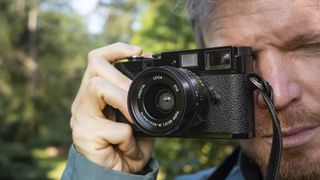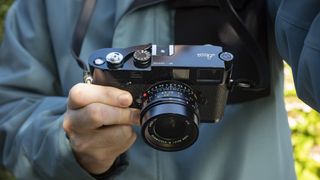Leica
MP:
two-minute
review
If
there’s
one
antidote
to
today’s
digital
imaging
with
its
instant
gratification
and
AI-powered
editing
trickery,
it’s
analog.
And
if
you
want
a
double
dose
of
the
old
school,
a
fully
manual
rangefinder,
such
as
the
Leica
MP,
will
do
the
trick.
Part
of
Leica’s
famed
M-mount,
the
MP
isn’t
as
old
as
it
looks,
being
released
as
recently
as
2003,
and
it’s
one
of
few
Leica
cameras
still
being
produced
today
and
is
therefore
available
new.
It’s
arguably
the
best
premium
film
camera
that
you
can
buy
new
today,
but
like
most
Leica’s,
its
price
is
eye-watering,
being
available
from
the
Leica
stores
and
leading
retailers
for
$5,995
/
£,5080
/
AU$10,190,
and
that’s
without
a
lens.
I
had
the
MP
with
the
28mm
f2
Summicron-M
APSH
lens
which
is
around
the
same
price
as
the
camera.
Gulp.
Suppose
it’s
the
retro
camera
experience
you’re
after,
and
the
same
35mm
film
format
hits
the
spot.
In
that
case,
you
can
find
alternative
analog
cameras
elsewhere,
secondhand,
for
a
mere
fraction
of
the
cost
of
a
Leica
MP.
You
don’t
even
need
to
buy
analog
to
bag
the
retro
look,
even
the
likes
of
Taylor
Swift
have
been
spotted
with
the
cheap
Olympus
OM-D
E-M10
IV,
one
of
our
favorite
mirrorless
cameras
for
beginners.
But
Leica
is
more
than
just
the
retro
look.
It’s
an
aspiration.
That
famed
red
dot
means
something,
whatever
depth
the
admirer’s
connection
is.
In
the
case
of
the
Leica
MP,
it
also
means
a
premium
“Handmade
in
Germany”
analog
camera
that
runs
as
smooth
as
butter.
As
a
rangefinder,
the
MP
is
an
altogether
different
camera
experience
to
your
cameraphone
or
one
of
the
best
mirrorless
cameras.
Learning
the
exposure
triangle
is
necessary;
how
shutter
speed,
aperture,
and
the
ISO
of
the
loaded
film
interplay.
You
can
download
a
free
light
meter
on
your
phone
to
take
a
light
reading
and
adjust
shutter
speed
or
aperture
accordingly
based
on
the
film’s
ISO,
or
purchase
a
dedicated
light
meter
if
you
want
to
avoid
your
phone
altogether
and
be
assured
that
you’ve
bagged
the
correct
brightness
in
your
photo,
even
if
you
won’t
truly
know
until
the
developed
film
is
returned.
(The
MP
does
also
have
an
LED
gauge
built
into
the
viewfinder
that
indicates
how
much
you
need
to
brighten
or
darken
your
exposure
settings
based
on
its
evaluative
metering.)
Beyond
the
exposure
triangle,
it’s
the
manual
focus
experience
of
a
Leica
rangefinder,
such
as
the
MP,
that
is
as
challenging
as
it
is
addictive.
This
is
a
far
cry
from
2024’s
best
autofocus
systems
–
there’s
no
rushing
with
a
rangefinder,
and
together
with
its
lens
system
that’s
limited
between
focal
lengths
of
21mm
to
135mm,
it’s
unsuitable
for
many
genres
of
photography.
You
won’t
be
able
to
nail
sharply
focused,
shallow
depth
of
field
portraits
of
people
or
animals
on
the
move,
unless
you
get
really,
really
lucky.
Outside
of
working
with
near-infinity
focusing
and
a
closed
aperture,
say
f/11,
where
ultimately
everything
is
just
about
in
focus,
your
subjects
will
need
as
much
patience
as
you
while
you
manually
rock
the
focus
back
and
forth
to
line
up
the
split
image
in
the
marked
out
central
area
of
the
viewfinder
to
nail
sharp
focus.
Taking
a
picture
with
a
rangefinder
is
slow,
purposeful,
and
frustrating
but
ultimately
a
wonderful
creative
process
for
those
who
persevere.
It’s
not
a
camera
for
all
the
time,
but
it
is
a
camera
that
could
just
renew
your
love
for
photography.
Sadly,
however,
with
the
Leica
MP,
most
people
are
priced
out
of
enjoying
the
experience.
Leica
MP:
Specs
to
scroll
horizontally
| Type: |
Analog rangefinder |
| Format: |
35mm film |
|
Lens mount: |
Leica M |
|
Lens system: |
Leica M lenses from 21mm to 135mm |
|
Shutter speed: |
1/1000sec to bulb |
| Dimensions: |
138 x 77 x 38mm |
| Weight: |
20.6oz / 585g |
| Colors: |
All-black or black and silver |
Leica
MP:
Price
and
availability
-
Body
only:
$5,995
/
£,5080
/
AU$10,190 -
Many
lenses
and
accessories
to
choose
from
The
Leica
MP
was
launched
in
2003
and
is
one
of
the
few
Leica
analog
cameras
that
is
still
available
to
buy
new.
On
the
Leica
store,
it
costs
$5,995
/
£,5080
/
AU$10,190.
Lens
choice
is
decent,
if
costly,
with
the
lower
end
of
the
price
range
close
to
the
price
of
the
MP
camera
itself.
There
are
third
party
lens
makers
such
as
Thypoch
that
have
created
Leica
M-mount
lenses
that
cost
a
mere
fraction
of
the
price.
with
a
number
available
for
under
$1,000
/
£700.
The
MP
is
also
compatible
with
a
host
of
Leica
accessories,
ranging
from
leather
cases
to
viewfinders
that
are
dedicated
to
specific
lens
focal
lengths.
Leica
MP:
Design
-
Stunning
all-metal
build -
Can
be
bought
new
and
its
mechanics
are
reliable -
Supported
by
a
range
of
Leica
M
lenses
Leica
cameras
are
expensive,
but
the
build
quality
of
these
“Handmade
in
Germany”
devices
is
undeniable.
Every
mechanical
component
runs
as
smooth
as
butter,
from
the
film
crank
to
move
onto
your
next
photo,
to
the
film
rewind
mechanism
once
the
roll
is
done.
You’ll
need
to
insert
a
tiny
CR
1/3N
battery
to
power
the
camera’s
evaluative
exposure
metering,
which
is
displayed
in
the
viewfinder
as
a
too-bright
/
too-dark
scale
and
is
linked
to
the
ISO
setting
on
the
camera’s
rear
ISO
dial
(the
new
Leica
M11-D
digital
rangefinder’s
design
pays
homage
to
this).
However,
as
a
fully
manual
camera,
you’ll
need
to
adjust
the
shutter
speed
and
aperture
yourself.
I
always
use
a
separate
light
meter
with
a
Leica
just
to
be
doubly
sure
I’ve
set
the
exposure
correctly.
But
you’ll
need
to
insert
a
roll
of
35mm
film
first.
Leica’s
design
ethos
here
is
simple
and
reliable;
a
fully
metal
twist
lock
on
the
underside
must
be
unscrewed
to
open
up
the
camera’s
underside,
and
you
remove
the
entire
bottom
plate
to
gain
access
to
the
film’s
holder.
Inserting
the
film
thereafter
is
a
tad
fiddly
but
in
truth,
once
you’ve
done
it
a
couple
of
times,
it’s
pretty
easy.

(Image
credit:
Future
|
Tim
Coleman)
I
only
tested
the
Leica
MP
with
a
28mm
f2
lens,
which
again,
is
a
gorgeous
bit
of
kit,
offering
a
generous
manual
focus
grip,
handy
focus
distance
scale,
and
an
aperture
ring.
With
Leica
you
get
the
whole
package;
a
lens
and
camera
built
to
high
standards
and
with
a
complimentary
aesthetic.
There’s
little
to
say
about
the
camera’s
external
controls.
You’ve
got
the
shutter
speed
dial
on
the
top,
the
beautiful
film
crank
that
reveals
its
brass
innards
through
the
scuffs
picked
up
over
time
and
heavy
use,
a
shutter
button
that
can
accept
a
screw-in
cable
release,
plus
the
ISO
dial
on
the
camera’s
rear.
The
aperture
is
adjusted
on
the
attached
lens.
For
me,
it’s
the
experience
of
manually
focusing
with
a
rangefinder
that
is
everything
about
the
MP:
it’s
as
frustrating
as
it
is
addictive.
For
all
the
will
and
the
practice
in
the
world,
you
won’t
be
able
to
nail
sharp
focus
on
a
moving
subject
when
focusing
closely
and
with
a
wide
aperture
and
therefore
shallow
depth
of
field.
Sure,
you
can
improve
your
hit
ratio
and
speed
at
which
you
can
obtain
sharp
focus,
but
ultimately,
the
Leica
MP
is
a
camera
that
slows
you
down,
and
in
today’s
fast-paced
world,
it’s
cathartic.
If
you’re
taking
portrait
pictures,
too,
that
extra
moment
it
takes
to
get
your
MP’s
settings
correct
can
open
up
your
subject
as
they
relax
and
give
you
a
window
to
their
soul
–
you’re
in
it
together.
Or,
the
slow
process
just
makes
them
feel
super
awkward
instead,
or
you
miss
the
moment.
It
can
go
either
way.

(Image
credit:
Future
|
Tim
Coleman)
Leica
MP:
Performance
-
Superbly
sharp
lenses
on
offer -
Reliable
mechanics -
Shutter
speed
maxes
out
at
1/1000sec
which
is
limiting
in
bright
light
One
benefit
in
choosing
the
MP
over
another
Leica
is
that
it’s
still
available
new,
and
with
that
comes
certain
reassurances
that
you
may
not
be
afforded
when
buying
secondhand
should
you
run
into
any
issues.
However,
I
wouldn’t
expect
that
of
the
MP
–
it’s
a
super-reliable
camera
that
should
last
you
a
lifetime.
Naturally,
the
quality
of
the
photos
produced
by
an
analog
camera
is
determined
by
the
lens
attached,
your
shooting
technique,
and,
of
course,
your
film
choice.
The
Leica
MP
enjoys
a
range
of
excellent
albeit
eye-wateringly
expensive
lenses,
like
the
28mm
f2
Summicron-M
ASPH
that
I
had
for
this
review.
If
money
is
no
object,
you
can
pick
up
a
range
of
Leica
M
prime
lenses
that
cover
the
focal
range
of
21mm
to
135mm.
The
photos
above
were
made
with
a
roll
of
Ilford
HP5
film,
ISO
400.
Next
time
I
use
a
Leica
analog
camera,
I’d
really
love
to
try
a
50mm
f/1.4-type
lens
and
some
of
the
other
lenses
for
portraits,
but
the
wide
angle
lens
I
had
for
testing
is
similar
if
a
tiny
bit
tighter
to
the
field
of
view
of
your
phone’s
main
camera
and
an
excellent
documentary
lens.
Here
lies
the
‘Leica
quality’
that
fans
talk
about.
Sure,
you’ll
struggle
to
beat
Leica’s
sharpness
in
the
analog
game,
but
if
you’re
expecting
the
clarity
you
get
from
one
of
today’s
best
digital
cameras,
you
might
have
to
think
again.
One
thing
that
digital
can
try
with
all
its
might
yet
never
quite
achieve,
however,
is
the
film
look.
You
aren’t
buying
an
analog
Leica
for
its
outright
image
quality
over
a
digital
counterpart
such
as
the
Leica
M11.
No,
you’re
buying
it
because
it’s
film
that
you
want
to
explore,
including
its
imperfect
quality.
Plus,
it’s
a
rewarding
hobby,
if
you
can
stomach
the
ongoing
costs
of
film
and
development.
The
above
photos
were
made
with
a
very
out
of
date
Fujifilm
Superior
X-Tra
ISO
400
roll
of
film.
It’s
best
practice
to
use
a
film
within
date,
but
you
can
get
some
whacky
one-of-a-kind
effects.
Sadly
on
this
occasion,
besides
a
purple-ish
hue,
the
risk
didn’t
pay
off
–
many
of
the
photos
came
out
underexposed.
There
are
very
real
limits
to
the
Leica
MP,
namely
its
maximum
shutter
speed
which
is
just
1/1000sec.
If
you’re
shooting
in
bright
light
and
with
a
wide
aperture
–
like
I
wanted
to
shoot
at
f2
with
the
28mm
lens
–
you’ll
need
an
ISO
100
film
or
even
slower.
However,
ISO
400
is
a
more
versatile
film
speed
if
you’re
going
to
be
shooting
in
mixed
lighting.
Once
the
film
roll
is
inserted,
you’re
locked
in,
you
can’t
switch
ISO
for
every
photo
like
you
can
with
a
digital
camera.
Should
you
buy
the
Leica
MP?
Buy
it
if…
Don’t
buy
it
if…

(Image
credit:
Future
|
Tim
Coleman)
How
I
tested
the
Leica
MP
-
Regular
use
over
the
course
of
two
weeks -
Paired
with
the
28mm
f2
Summicron-M
APSH
lens -
Both
color
and
black
and
white
film
developed
Leica
loaned
me
the
MP
together
with
the
28mm
f2
Summicron-M
ASPH
lens
for
two
weeks,
during
which
time
I
photographed
everything
from
sweeping
vistas
to
busy
London
street
scenes.
I
have
shot
with
both
color
and
black
and
white
film,
usually
sticking
with
versatile
ISO
400
films.
I
sent
the
films
to
a
lab
to
be
developed
and
was
provided
with
standard-quality
digital
scans
to
assess
image
quality.
-
First
reviewed
September
2024
